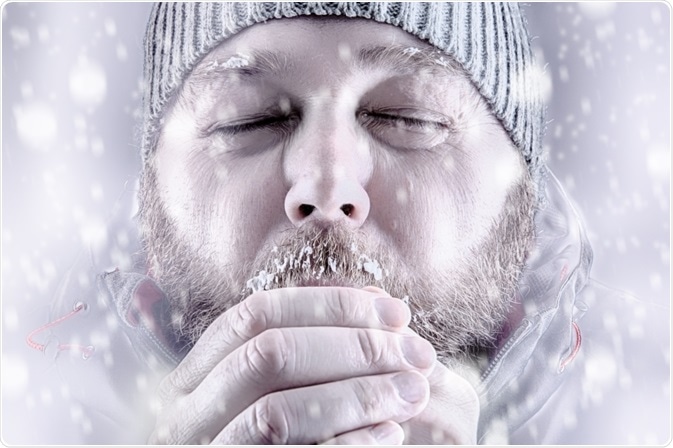Hypothermia is defined as a dangerously low body temperature, below 95 F.

Image Credit: Simon Bratt / Shutterstock.com
Symptoms
A person with hypothermia will often manifest several or all of the following symptoms:
- Sleepiness
- Inability to think or talk clearly
- Clumsiness
- Pale cold skin
- Weakness
- Exhaustion
- Uncontrollable shivering
- Slow breathing or heart rate
- Lethargy
In infants, hypothermia may be suspected when the skin is very red and cold, and there is a loss of normal activity.
Extreme cold affects neurological processes, thus leading to confusion and poor judgment. As a result, a hypothermic person often fails to realize the danger of exposure and cannot resist irrational decisions, such as going to sleep without getting shelter and warmth.
Shivering ceases at very low temperatures. Therefore, without prompt effective treatment, cardiac arrest occurs, resulting in death.
Protective responses against hypothermia
During the early stages of hypothermia, several protective responses by the body will arise. Certain behavioral responses, for example, can include walking around, waving the arms, and getting shelter.
In addition, the body will initiate certain physical responses to protect itself against the cold. These physical responses can include shivering, the development of goosebumps on the skin, and closure of skin blood vessels to shunt blood to the core. Taken together, these physical responses help to keep vital bodily functions running. Stress hormones are also released to burn more heat and warm the body.
Risk factors
A person's age, for example, can determine their ability to protect themselves from the adverse effects of hypothermia. Younger individuals, for example, are less likely to protect themselves from hypothermia and keep themselves warm. Additionally, younger people tend to lose more heat because of increased metabolism.
Comparatively, older individuals often have reduced subcutaneous fat; therefore, there is less natural insulation against the cold. Individuals of older age also tend to have a slower metabolism and are less able to sense colder temperatures well because their skin has fewer nerve endings. Additionally, older individuals often suffer from social isolation, which makes it easier for them to drift into hypothermia without anyone noticing.
Several additional risk factors can cause an individual to be at a greater risk of hypothermia, including:
- Circulatory problems, such as heart disease
- Sickness
- Poor nutrition
- Fatigue
- Alcohol consumption dilates the skin vessels, which increases heat loss through the skin
- Any condition which reduces the metabolic rate
- Reduced consciousness
- Impaired judgment
- Drug abuse
- Certain medications
- Dementia
- Being wet or sweaty for a long time
- Immersion in the water below body temperature for more than a few minutes
- Other medical conditions which cause immobilization
Precipitating factors
When certain risk factors are present, hypothermia may be precipitated by any of the following factors:
- Getting soaked
- Exposure to cold or wind while in wet clothing
- Exposure to cold without sufficient clothing
- Overexertion
- Failure to eat or drink enough in cold weather
Prevention of hypothermia
There are several precautions that people can take to protect themselves against hypothermia.
Dressing warmly and in multiple layers, which can include a cap, mufflers, mittens, and socks, is often recommended, particularly if the individual will be outside in the cold weather. Even if the individual will only be driving, it is generally recommended that they still dress warmly in the event that they need to leave the car.
In addition to wearing multiple layers, it is also recommended that individuals have a weatherproof outer layer to keep themselves dry. Insulated boots can also assist in protecting the feet and toes from hypothermia. In the event that an individual might get wet, it is also useful to pack an additional pair of dry clothes.
Diagnosis of hypothermia
Emergency Medicine - Hypothermia: By Daniel Grushka M.D.
Hypothermia occurs in three phases, which include mild, moderate, and severe hypothermia.
Mild hypothermia
Defined as a core body temperature of 32-35 C, an individual with mild hypothermia will have a pale appearance. Additionally, the skin will feel cool and the extremities will be numbed. The individual with hypothermia at this stage will also appear sluggish, drowsy, shivering uncontrollably, and exhibit both rapid heart and breathing rates.
Moderate hypothermia
In moderate hypothermia, the affected individual's core temperature will drop to 28-32 C. At this point, the victim lapses into unconsciousness, and shivering will stop.
There may also be involuntary urination due to the excessive production of urine. This occurs because the shut-down of skin circulation frees more blood to flow through the kidneys instead. The heart rate, breathing, and blood pressure drop further at this stage of hypothermia as well.
Severe hypothermia
In severe hypothermia cases, the core temperature is very low, below 28 C. By this stage, the person is unconscious and cannot be resuscitated. The heartbeat is very slow and sometimes irregular until it ultimately stops beating. The pupils also become unreactive, while the muscles are stiff and rigid. The breathing and pulse are often imperceptible in severe hypothermia cases.
References
Further Reading